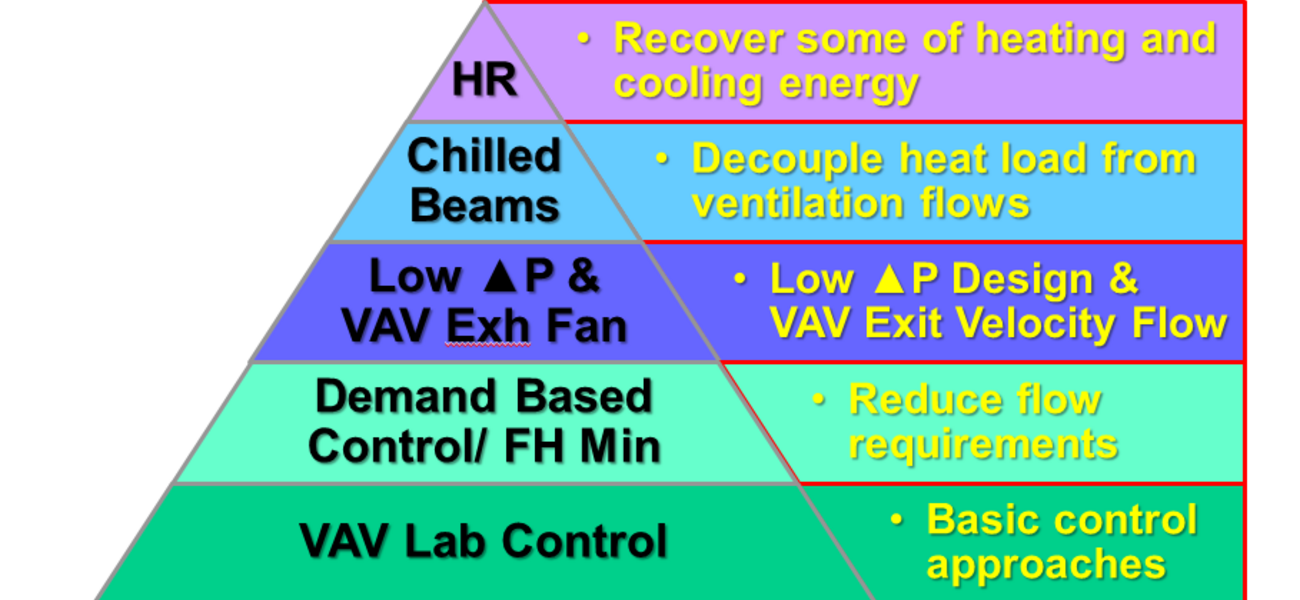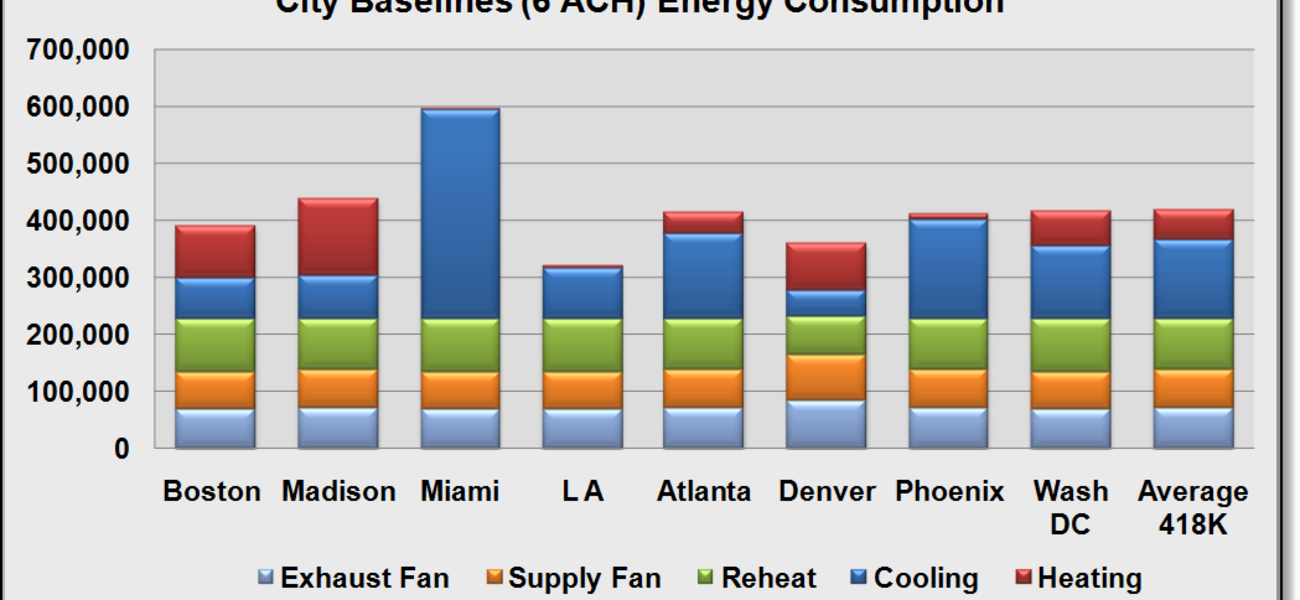Near net-zero energy usage is achievable for laboratory buildings only by employing a holistic approach that examines how all the available energy-saving technologies work together before focusing on a few, high-impact concepts. These concepts not only reduce energy costs by 50 percent or more, but also can significantly reduce upfront costs. Employed piecemeal, however, they can backfire.
Take airflow, for example. Because airflow is the biggest driver of energy usage in labs, airflow reduction is the key to savings. Utilizing energy models is important, though, since low-flow design can lessen the effects of other energy-saving concepts, says Gordon Sharp, chairman and founder of Aircuity, Inc.
Achieving net-zero energy for a laboratory building alone (where all necessary power is generated on the building itself) is difficult, adds Sharp, because the typical energy output from solar panel technology is only 10 to 20 kWh per sf, and the minimum energy consumption for most labs is 15 to 40 kWh per sf. But achieving net-zero for an entire site is possible by reducing the lab’s energy usage in conjunction with generating energy with photo-voltaics elsewhere on site.
“Net-zero is challenging for a lab, because of the square footage involved and the amount of power density. The problem, or maybe the opportunity, is if we work well with the lab, we can probably get energy usage down low enough that, technically, it is a net-zero lab. However, to have all the solar photovoltaics on the building itself, it would have to be either one story or only a few floors with a lot of office and non-lab spaces, as well.”
Focus on Designs that Maximize Savings
Energy and cost savings can be maximized in lab settings by focusing on a few targeted, high-impact concepts, says Sharp.
“You can get the bulk of the savings with a few ideas versus trying to do 20 different things, each generating 2 percent savings.”
Sharp’s company developed an energy analysis tool that holistically evaluates a lab’s needs and focuses on its unique requirements. The majority of a lab’s energy is used for heating/cooling outside air, so available tools that focused on building envelopes weren’t effective. Aircuity’s model calculates probable energy and upfront costs, taking into account the proposed design and outside climate, and how various energy-saving approaches would work within those parameters.
“All these technologies interact, and if you look at each product separately, that doesn’t account for the interaction and often adds up to more cost than energy savings,” he says. The U.S. Department of Energy (DOE) has expressed interest in using this analysis tool, which has already been accepted by utility companies and others.
In conjunction with the analysis, Sharp recommends a pyramid approach to modeling energy systems. The systems with the most impact form the foundation, or pyramid base. The ascending layers play increasingly lesser roles in energy savings. The five levels, starting with the base, are:
- Variable air volume (VAV), or basic airflow control approaches
- Demand-based control and fume hood minimums
- Low pressure drop design and VAV exit velocity flow
- Chilled beams
- Heat recovery
“To optimize lab safety, first cost, and energy, combine systems based on analysis of net benefits,” he advises.
The Pyramid Approach
To begin reducing lab airflow, says Sharp, look at the three main factors that impact it:
- Makeup air for exhaust devices, such as fume hoods, biosafety cabinets, and animal cage racks
- Thermal loads
- Air changes per hour (ACH) ventilation dilution rates.
Whichever factor is highest will dictate the lab airflow, says Sharp. Reductions in one area do not necessarily affect overall energy consumption. For example, to save on thermal energy, a lab can use more efficient freezers, but doing so could increase HVAC energy, because those freezers were generating heat and possibly reducing reheat costs.
“While it’s good to get more efficient freezers, you then have to reduce your airflow in these areas, or it’s not going to generate as much HVAC energy savings as you might think. Look at all these requirements and reduce each one.”
There are various means to reduce airflow from fume hoods, including high-performance devices such as low face velocity hoods and filter or ductless hoods. Encouraging good sash-closing habits helps, or use automatic sash-closing technology.
For labs with a moderate to high density of hoods, new ANSI Z9.5 minimum fume hood airflow requirements promote significant energy savings, says Sharp. The new recommended range allows for as low as 100 cfm for a 6-foot hood when the sash is closed. For extremely high-density labs, such as six to eight hoods in 1,000 sf, keeping the sashes down and using low fume hood airflow minimums is probably the only way to reduce airflow, adds Sharp.
Typical thermal loads for labs are 2.5 to 3 watts per sf, which would require less than four ACH during the day to cool the room, he adds. Reducing the ACH in a lab environment to two to four during the day and two at night is an achievable goal. If high thermal loads are the culprit, using chilled beams or hydronic cooling to decouple the airflow from the actual thermal loads is beneficial, he adds.
Demand-based control is one of the best ways to lower ACH in the lab room. A system of centralized sensors monitors the indoor environment for contaminants about once every 15 minutes. If the air is clean, the airflow minimum is reduced to as low as two ACH; when air contaminants are sensed, the airflow is increased to eight to 16 ACH.
“When air contaminants are sensed, we want to ‘purge’ the lab or go to a higher airflow,” notes Sharp. “But 98 percent of the time the lab air is clean, and a low ventilation rate can be used.”
Sharp’s company has done more than 500 projects with the demand-based control concept, and this approach is even referenced in the ASHRAE HVAC Applications handbook.
“This performance-based approach to airflow control within labs creates a dramatic reduction in the airflow and the energy required to operate a laboratory. When you do that, you can reduce capital cost, as well, because less airflow capacity and HVAC equipment are required.”
Variable exhaust fan exit velocity control also can lower airflow. Typically, exhaust fans run at a constant flow with a high exit velocity, so exhaust air doesn’t flow back into the building or into other buildings nearby. A damper adds roof air to the exhaust when this airflow drops in order to maintain constant flow. To save energy, one or more manifold fans can be staged, or sequentially turned off, as the building airflow is reduced. However, even staged exhaust fans can consume more than two times the energy of exhaust fans operating in variable air volume or VAV mode, says Sharp.
When wind speed is low enough and coming from the right direction, the exhaust discharge velocity can be reduced without increasing its reentry into the building. A wind responsive exhaust fan control system uses anemometers, controls, and a table determined by wind tunnel testing to reduce the exhaust fan airflow under certain wind speed and direction conditions.
A demand-based approach that measures the contaminants in the exhaust air can save even more energy, says Sharp. When the exhaust air is clean or has a low contaminant level, the airflow can be reduced while limiting reentry to safe levels. When contaminants are detected, the exhaust fan flow is increased. For most labs, the exhaust air is clean 98 percent of the time.
Another approach is low-pressure-drop design. Typical HVAC designs might have a combined exhaust and supply pressure drop of about 10 inches, whereas good design can achieve 6.5 inches, says Sharp. “If you really work at it, you might be able to get to a design as low as 4 inches of total supply and exhaust. The energy savings of this design is similar in magnitude to the exhaust fan control approach.”
Combining Systems
Chilled beams are higher on the pyramid because, although they are a great energy-saving concept, they work most effectively when coupled with reduced airflow and demand-based control, says Sharp. Cooling requirements in most labs are low, so beams placed in a lab with six to eight ACH won’t get used often, because the necessary cooling comes from the airflow itself.
If a demand-based approach can be used to reduce outside airflow requirements for dilution ventilation, then chilled beams can decouple the outside air and supply airflow requirements. When the lab’s cooling requirements exceed the cooling provided by the two to four ACHs in demand-based control, then the chilled beams will take care of additional cooling requirements.
“The best approach is, reduce the outside air and let the beams do their job.”
This also enables a downsizing of the HVAC system, because its use is based on the ventilation requirements of the lab, which are going to be low most of the time, adds Sharp. The combination of chilled beams and demand-based control results in lower HVAC system upfront costs. These savings are usually higher than those realized from conventional VAV control or chilled beams alone, he notes.
Heat recovery is at the top of the pyramid because for all but extremely cold or extremely hot and humid climates, it often provides less savings, says Sharp, especially compared with reducing airflow.
An enthalpy wheel provides the most effective and efficient means to recover and transfer thermal-related energy and humidity-related energy. This large, porous wheel rotates through the exhaust airflow stream on one side and the fresh air stream on the other, swapping the airstreams and transferring moisture and temperature in the process. Since a small amount of contaminants carries over from the exhaust to the supply airstream, these wheels should be used only with airflows that are strictly room exhaust, with no fume hood exhaust.
Runaround loops—two linked coils filled with a heat-conduction liquid such as glycol—can be used to safely transfer sensible energy or thermal energy only from the fume hood exhaust to the supply air. They can be effective in cold climates but don’t offer as much savings in more temperate or warm and humid climates, and in some cases can increase costs, says Sharp.
“It is important to remember that these coils cause a significant pressure drop, and you have to pay for that pressure drop in energy. This energy cost reduces the total thermal savings, so the result in some cases can actually be a net increase in total energy used.
“If you’re going to use heat recovery, take maximum advantage of its ability to reduce the chiller and heating system peak load requirements by downsizing your HVAC system, because that’s where significant benefits and payback potential exist.”
Enthalpy wheels offer more payback in cold and dry climates or very humid environments, whereas runaround loop systems are best applied in colder environments, where there is more heat energy to be recovered.
“It is also important to remember that if variable air volume and demand-based systems are used to cut the airflow rates significantly, there’s less for the heat recovery systems to do. That’s part of the reason the savings may not be as not as much as expected,” says Sharp. “On the other hand, reducing the lab airflows can potentially reduce the heat recovery systems’ size, which will partially improve payback.”
Energy Savings in Action: Case Studies
These energy-saving technologies and philosophies work well even in extreme climates, says Sharp. One example is the Masdar Institute of Science and Technology (MIST) in Abu Dhabi, where temperatures can get up to 120 degrees with high humidity. The project consisted of two buildings totaling 1.5 million sf, about 250,000 nsf of which is lab space. Their goal was to build sustainable but also economically viable facilities without spending millions.
Using the energy analysis tool, Sharp looked at how much the energy costs would be for a smaller lab project of about 125,000 gsf, with 50,000 nsf of lab space and 30,000 nsf office space—about one-fifth of the total project. Factoring in a conservative minimum ACH baseline of six, local energy costs, a low to moderate density of hoods, and the Abu Dhabi climate, he concluded that baseline energy usage would be $600,000 for that portion, or $3 million total annually. Cooling costs constituted 60 percent of the total energy use.
The analysis showed that combining several high-impact approaches could achieve a 74 percent energy savings. Demand-based control reduced airflow to two ACH minimum day and night when the lab air was clean, and up to 14 ACH when contaminants were detected. Fume hoods were operated with automatic sash closers and airflow minimums at 100 cfm, or 150 hood ACH when the sash is closed. Chilled beams, some aspects of low pressure-drop design, and an enthalpy wheel were also employed, says Sharp. Demand-based control alone reduced lab HVAC energy costs by $322,000 annually, or 53 percent. The system paid for itself in 1.4 years, he adds.
The HVAC system capacity also was reduced significantly for MIST, resulting in upfront cost savings. Even more importantly, the lower energy requirements reduced the size of the photo-voltaics needed to run the buildings and achieved a near net-zero result for the site. The demand-based control, even with the impact of the other energy savings approaches, saved about 9,000 megawatt hours for the whole project, or about four megawatts of solar capacity—roughly $20 million of first cost, according to Sharp.
This same project in a climate like Boston’s generates a slightly higher reduction in energy—77 percent. The use of demand-based control and a reduction of minimum ACH levels from six to four (when occupied) and two (when unoccupied) achieved a 13 percent reduction in peak HVAC airflow, for an HVAC capital cost savings of $280,000 annually. If chilled beams, a VAV exhaust system, and heat recovery are used along with a demand-based control system operating at two ACH minimum day and night, then the initial cost of the HVAC system, chilled beams, and heat recovery can be reduced by $850,000. Even with the cost of the demand-based control system, this approach generates a first cost reduction of $386,000, notes Sharp
A Paradigm Shift
Low airflow lab design represents a paradigm shift, but the savings are so significant and easily achievable, it should be used as the foundation for efficiency, believes Sharp.
Utilizing these savings measures also allows for more open and flexible lab designs, because you are creating an environment more akin to an office than a lab. And the low airflow designs can be adapted to work in any climate.
“The bottom line is: Do your analysis, make sure each energy-saving concept makes sense for your situation, and then apply it appropriately.”
By Taitia Shelow
This report is based on a presentation Sharp made at Tradeline’s 2014 International Conference on Research Facilities.
| Organization |
|---|
|
Aircuity Inc.
|



